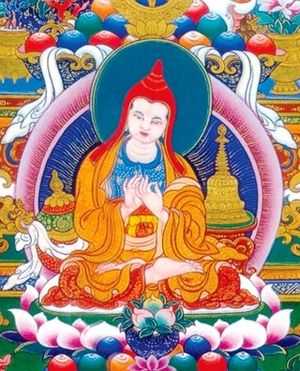Kadampa: Difference between revisions
Jump to navigation
Jump to search
No edit summary |
|||
| Line 3: | Line 3: | ||
==Further Reading== | ==Further Reading== | ||
*''The Book of Kadam—The Core Texts'', translated by [[Geshe Thupten Jinpa]], Wisdom Publications, 2008. | *''The Book of Kadam—The Core Texts'', translated by [[Geshe Thupten Jinpa]], Wisdom Publications, 2008. | ||
*''Wisdom of the Kadam Masters'', translated & introduced by Geshe Thupten Jinpa, Tibetan Classics, Volume 2, Wisdom Publications, 2013. | |||
==Internal Links== | ==Internal Links== | ||
Revision as of 20:54, 30 October 2016

Kadampa (Wyl. bka' gdams pa) — the tradition founded by Atisha in which all the Words (ka) of the Buddha are taken as practical instructions (dam). The Kadampa tradition followed the lamrim ('graded path') approach of the three levels of spiritual capacity set out by Atisha in his Lamp for the Path of Awakening. They relied upon the so-called 'seven divine dharmas', i.e., the four deities of Shakyamuni, Avalokiteshvara, Tara and Achala, and three pitakas.
Further Reading
- The Book of Kadam—The Core Texts, translated by Geshe Thupten Jinpa, Wisdom Publications, 2008.
- Wisdom of the Kadam Masters, translated & introduced by Geshe Thupten Jinpa, Tibetan Classics, Volume 2, Wisdom Publications, 2013.